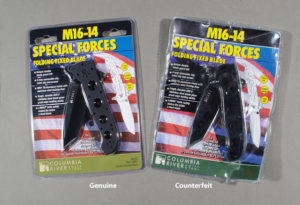
Fake knives—better known as counterfeit knives—are a worldwide problem that needs everyone concerned to pay attention, and National Fraud Awareness Week Nov. 12-18 is a good time to sit up and take notice.
Factory knife companies are especially prone to having their knives counterfeited by nefarious operations, the latter usually based overseas. The American Knife & Tool Institute has a dedicated program tailored to fight the plague of fake knives, and other cutlery companies such as Browning, CRKT, Cold Steel, Chris Reeve Knives, Knifeart and others have websites that address the scourge.
What can you do? Visit the above sites and others and familiarize yourself with the situation concerning counterfeits of those companies’ knives. While some custom knives are victims of counterfeits as well, it’s largely the factory guys that are targeted simply because their knives are recognized by many and sold on a much larger scale than custom knives, and can earn the counterfeiters much more illicit money as a result.
One thing to keep in mind is exactly what is meant here by counterfeit knife. We are not talking about design features, designs, etc., that are “knocked off” without the original maker/designer’s OK or approval. That is another matter entirely. There are some instances of where knockoffs are done and the parties involved eventually wind up in court to settle the issue. If the matter cannot be resolved otherwise, the original designer ultimately may have to prove that the design feature, design, etc., is his or hers exclusively, it has not appeared on another knife before, etc. As you can imagine, since knives have been around since the dawn of humanity, such a thing many times can be very difficult to prove. However, again, knockoffs are not the issue here.
The issue here is a counterfeit knife in which the counterfeiter has copied everything in question about the knife, from the knife’s exact features, blade stamp and even the product box in which the knife is packaged. The product box even will illegally sport the knife and company’s name, the company’s address, etc. Then, when the unsuspecting buyer purchases the fake knives and sends them to the company about a warranty issue, the company in question has the unsavory duty of telling the buyer that he or she has been duped by counterfeits, and the company cannot honor the warranty. The buyer is then stuck with worthless fake knives.
Some of the counterfeits are easy to identify because they are shoddily done. Others, however, are not as easy to spot. It’s a growing problem, one that knife companies and knife enthusiasts everywhere—including you—must continue to deal with and be vigilant about. For more information look for Daniel Jackson’s story on counterfeit knives in the January 2018 BLADE®, on newsstands Dec. 26.
BLADE’s annual Knife Guide Issue features the newest knives and sharpeners, plus knife and axe reviews, knife sheaths, kit knives and a Knife Industry Directory.Get your FREE digital PDF instant download of the annual Knife Guide. No, really! We will email it to you right now when you subscribe to the BLADE email newsletter.
Click Here to Subscribe and get your free digital 2024 Knife Guide!